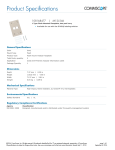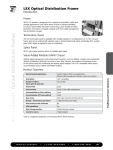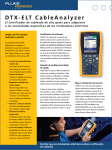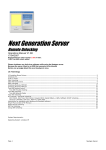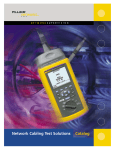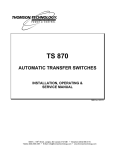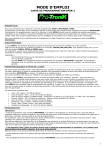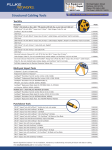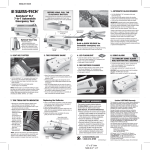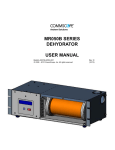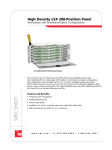Download Performance Verification of GigaSPEED® XL
Transcript
SYSTIMAX® Solutions Performance Verification of GigaSPEED® XL Installations with Fluke Networks DSP-4x00 Series Testers February 2004 www.commscope.com The SYSTIMAX® GigaSPEED® XL Solutions and their performance specifications are offered in two versions, depending on the GigaSPEED XL cable type used. The GigaSPEED XL7 Solution utilizes 71E series cables and the GigaSPEED XL8 Solution utilizes 81A series cables. The GigaSPEED XL components for each solution are listed in the table below. GigaSPEED XL7 Solution GigaSPEED XL8 Solution 71E Series Cables (1071E/2071E/3071E) 81A Series Cables (1081A/2081A/3081A) MGS400 Modular Outlets PATCHMAX® GS3 Modular Patch Panels 1100 GS3 Modular Patch Panels iPatch® GS3 Modular Patch Panels VisiPatch® GS3 Cross-connect Systems GS8E Modular Cord Family GigaSPEED XL Guaranteed Channel Performance Registered GigaSPEED XL installations in conformance with the relevant SYSTIMAX guidelines are covered by the SYSTIMAX 20 Year Assurance Program, and are also backed by the GigaSPEED XL Minimum Channel Performance Guarantees up to 250 MHz. The GigaSPEED XL Minimum Channel Performance Guarantees exceed the Category 6 channel specifications in TIA 568B.2-1 and the Class E channel specifications in the ISO/IEC 11801 2nd Ed. (2002) by significant margins on a swept frequency basis, as outlined in the SYSTIMAX Labs memorandum entitled “SYSTIMAX® GigaSPEED® XL7/8 Channel Performance Specifications”. GigaSPEED XL guaranteed channel performance margins for 4 and 6-connector channels over the entire frequency range (1-250 MHz) are listed below: 4-Connector Channel Guaranteed Margin GigaSPEED XL7 GigaSPEED XL8 Insertion Loss 5% NEXT 6 dB PSNEXT ELFEXT 6-Connector Channel Guaranteed Margin GigaSPEED XL7 GigaSPEED XL8 7.5 % 4% 6.5 % 7 dB 4 dB 5 dB 7.5 dB 8.5 dB 5.5 dB 6.5 dB 6 dB 8 dB 4 dB 6 dB PSELFEXT 8 dB 10 dB 6 dB 8 dB Return Loss 4 dB 4 dB 2 dB 2 dB www.commscope.com 2 Performance Testing of SYSTIMAX Installations For installations designed and registered by a SYSTIMAX-certified BusinessPartner in accordance with the relevant SYSTIMAX Design and Installation guidelines, CommScope guarantees end-to-end channel performance. Therefore, CommScope does not require certification testing for SYSTIMAX installations. Wire map testing is the minimum mandatory requirement. However, many customers request performance testing of a percentage or all of the installed links and/or channels. CommScope is fully supportive of field testing practices and has provided valuable contributions to standards developments and test set manufacturers to enable the accurate testing of SYSTIMAX installations. Test Configurations Cabling standards define the following test configurations for installed cabling: The Channel configuration includes all the end-to-end cabling components necessary to interconnect two communications devices. Therefore, channel performance determines the overall quality of the communications and provides a true indication of end-to-end cabling system performance. All applications refer to end-to-end channel performance. The Permanent Link configuration only includes the “permanently” installed cabling (no cords or crossconects). (Note: ISO/IEC 11801 2nd Ed. additionally defines a length-dependent CP Link configuration for testing of cabling up to the Consolidation Point). CommScope supports both Permanent Link and Channel testing. Permanent Link tests are most commonly performed by installers, since channel tests should be performed with the cords that will remain in-situ for each channel. However, applications rely on end-to-end cabling system channel performance. Therefore, the Guaranteed GigaSPEED XL Channel Performance margins apply to GigaSPEED XL channel configurations. Channel Configuration The Channel configuration is intended to be used by system designers, installers, and users of data telecommunications systems to verify the end-to-end performance of cabling systems. It is important to note that the Channel includes the work area cords, equipment cords and crossconnects that make up the end-to-end cabling system. Channel under test Work area equipment A B WA C D CP Cables and cords Work area cord Optional transition cabling Horizontal cabling Patch cord Telecom Room/Floor Distributor Horizontal cross-connect or equipment cord C1 E Equipment in TR/FD C2 A B C D E Connecting hardware Telecommunications outlet/connector Optional transition/consolidation point connector. Horizontal cross-connect or interconnect. WA CP C1, C2 Maximum length B + C. A + D + E 90 m (295 ft) 10 m (32.8 ft) www.commscope.com 3 The elements of the common channel definition found in TIA-568B, and ISO/IEC 11801 2nd Ed. are shown in the figure above. The 4-connector channel limits are based on 90 m of horizontal cable, a work area cord, a telecommunications outlet/connector, an optional transition point close to the work area, and across-connect in the telecommunications closet. The combined length of equipment cords, patch cords, and jumpers shall not exceed 10 meters. A 15 m minimum length of cable between CP and C1 in the figure above is recommended by TIA/EIA 568B, and is required by ISO/IEC 11801 2nd Ed. The connections to the equipment at each end of the channel are not included in the channel definition. Note: The ISO/IEC 11801 2nd Ed. also includes 2-connector and 3-connector channel configurations Permanent Link Configuration The Permanent Link configuration is intended to be used by system designers, installers, and users of data telecommunications systems to verify the performance of cabling installed between the telecommunications closet and the work area outlet. It is important to note that the Permanent Link configuration includes the optional Consolidation Point (if present) but does not include the work area cords, equipment cords, or cross-connects that make up the end-to-end cabling system. Permanent Link Field test instrument F E WA C F CP Field test instrument C1 Cables and cords Test equipment cord Optional transition cabling Horizontal cabling F B C Connecting hardware Telecommunications outlet/connector Optional transition/consolidation point connector. Horizontal cross-connect or interconnect. WA CP C1 Maximum length B + C. 90 m (295 ft) A schematic representation of the Permanent Link definition in TIA-568B and ISO/IEC 11801 2nd Ed. is shown in the figure above. The Permanent Link limits are based on up to 90 m (295 ft) of horizontal cabling and up to 3 connections (including the optional Consolidation Point). A 15 m minimum length of cable between CP and C1 in the figure above is recommended by TIA/EIA 568B, and is required by ISO/IEC 11801 2nd Ed. The Permanent Link excludes both the cable portion of the field test instrument cord and the connection to the field test instrument. The CP Link The CP Link defined in ISO/IEC 11801 2nd Ed. is intended for testing of Consolidation Point installations in cases where the transition cabling (labelled B in the figure above) is not present. The CP Link test limits for insertion loss, ACR, PSACR, ELFEXT, PSELFEXT, d.c. loop resistance, delay, and delay skew are length-dependent. www.commscope.com 4 Field Testing of GigaSPEED XL Installations with the Fluke DSP-4x00 Series The Fluke DSP-4x00 Series of hand held instruments have been qualified by CommScope Labs for verification of the Guaranteed GigaSPEED XL Channel Performance as well as Permanent Link testing to the Category 6 / Class E specifications. In order to perform accurate testing, it is important to ensure the following: 1. Verify that the latest instrument software is installed in the tester 2. Calibrate the instrument according to the recommendations from the vendor 3. Select the correct interface adapters and test cords 4. Execute the correct Autotest for the configuration to be tested DSP-4x00 Series Instrument Software It is very important to maintain the software of the instrument up-to-date. The most recent versions of DSP-4x00 series software can be downloaded form the Fluke Networks web site at http://www.flukenetworks.com DSP-4x00 Series Calibration To obtain accurate test results, it is critical to ensure that the instrument is properly calibrated. Fluke Networks recommends factory calibration every twelve months, and field calibrations every 30 days. The calibration procedures are detailed in the User Manual provided with the tester and/ or test adapters. For a brief overview of field calibration procedures and a quick-check procedure of instrument calibration, please refer to Annex A. DSP-4x00 series Channel Adapters The DSP-4x00 is shipped with two channel adapters. The DSP-LIA012 and DSP-LIA013 Channel Adapters (see figure below) have “RJ45” interfaces to connect to each end of the channel to be tested. (Note: The DSP-LIA013 has a second jack for traffic analysis. For channel testing, the jack labelled “Cable Test” must be used). DSP-LIA012 DSP-LIA013 www.commscope.com 5 DSP-4x00 series Permanent Link Adapters For Permanent Link testing, the DSP-4x00 series utilizes a Universal Permanent Link Adapter (DSPLIA101S) and Personality Modules with either modular or 110 plugs to connect to the Permanent Link under test (see figures below). www.commscope.com 6 Verifying Permanent Link Performance of GigaSPEED XL installations For Permanent Link performance testing, a properly calibrated DSP-LIA101 Universal Permanent Link Adapter must be used. Currently there are two Personality Modules available for testing of GigaSPEED XL Permanent Links: the DSP-PM25 and the DSP-PM06. The DSP-PM25 was the first Category 6 compliant Personality Module and was constructed with a GigaSPEED XL GS8E plug. The DSP-PM06 is a newer Category 6 Personality Module based on a centered plug designed by Fluke Networks, and is expected to replace the DSP-PM25 in the Fluke Networks catalogue. For testing of VisiPatch installations, the DSP-PM10B (T568B wiring) or the DSP-PM10A (T568A wiring) can be used. The figures below illustrate the different DSP Personality Modules suitable for SYSTIMAX Solutions. The correct Autotest and Personality Modules for Permanent Link testing of GigaSPEED XL installations are listed in the table below: GigaSPEED XL Permanent Link Performance Testing Autotest TIA Cat 6 Perm. Link1 ISO11801 PL max Class E2 EN50173 PL Class E2 Personality Modules Modular Hardware (MGS400, 1100GS3, PatchMAX GS3) DSP-PM063 DSP-PM253 VisiPatch Panels DSP-PM10B (T568B) or DSP-PM10A (T568A) Notes: 1. The TIA Cat 6 Permanent Link autotest incorporates a 3 dB rule for Return Loss 2. The IS11801 and EN50173 Perm Link autotests incorporate a 3 dB rule for Return Loss, and a 4 dB rule for Insertion Loss, NEXT, PSNEXT, ACR, and PSACR. 3. Either Personality Module can be used for GigaSPEED XL installations, but as it is expected that the DSP-PM06 will replace the DSP-PM25 in the Fluke Networks catalog going forward, the DSP-PM06 is the recommended Personality Module for newer GigaSPEED XL installations. Compliance with the Category 6/Class E Permanent Link specifications is demonstrated by achieving PASS results for all autotest parameters. www.commscope.com 7 GigaSPEED XL Permanent Link configurations are shown below. 2-Connector GigaSPEED XL Permanent Link DSP -PM06 -PM25 or DSP -PM25 -PM02 or DSP -PM10A or DSP -PM10B MGS400, PatchMAX GS3, 1100 GS3, or VisiPatch MGS400 1 2 Perm Link Start DSP -LIA101 DSP -PM06 -PM25 or DSP -PM25 -PM02 Perm Link End 71E or 81A Cable DSP -LIA101 Maximum Permanent Link Length = 90 m 3-Connector GigaSPEED XL Permanent Link DSP -PM06 -PM25 or DSP -PM25 -PM02 or DSP -PM10A or DSP -PM10B MGS400, PatchMAX GS3, 1100 GS3, or VisiPatch 1 MGS400 2 3 Perm Link Start DSP -LIA101 DSP -PM06 -PM25 or DSP -PM25 -PM02 Perm Link End 71E or 81A Cable DSP -LIA101 GS8MGS or MGS400 connector terminated on GS3117 Cord or single ended GS8E Maximum Permanent Link Length = 90 m Additionally, building backbone permanent links and CP links may also be tested according to these guidelines. If CP Links are tested as per ISO/IEC 11801 2nd Ed., it is necessary to verify that there is sufficient insertion loss and delay skew margin to accommodate any additional cabling, and/or label the CP links according to length. www.commscope.com 8 Verifying Channel Performance of GigaSPEED XL Installations Compliance of installed GigaSPEED XL Channels with the Guaranteed GigaSPEED XL Channel Performance margins may be verified once the SYSTIMAX Work Area Cords, Patch Cords and Equipment cords are installed. For Channel performance testing, the channel adapters provided with the DSP-4x00 series instruments must be used to interface to the GigaSPEED XL cords at each end of the channel. The correct Autotests and adapters for GigaSPEED XL channel testing are listed in the table below: GigaSPEED XL Permanent Link Performance Testing Autotest TIA Cat 6 Channel1 ISO11801 Channel Class E2 EN50173 Ch Class E2 Channel Adapters DSP-LIA012 DSP-LIA013 Notes: 1. The TIA Cat 6 Channel autotest incorporates a 3 dB rule for Return Loss 2. The IS11801 and EN50173 autotests incorporate a 3 dB rule for Return Loss, and a 4 dB rule for Insertion Loss, NEXT, and PSNEXT . Compliance with the guaranteed GigaSPEED XL channel performance specifications is achieved by channel test results that show PASS for all Category 6 / Class E requirements and performance margin that is equal to or better than the GigaSPEED XL Guaranteed Channel Margin. www.commscope.com 9 GigaSPEED XL Channel Configurations are shown below. 4-Connector GigaSPEED XL Channel MGS400, PatchMAX GS3, 1100 GS3, or VisiPatch GS8E Cord or GS3117 Cord Channel Start 1 2 MGS400 4 3 GS8E Cord GS8E Cord 110VP8-GS3 Cord or 119VP8-GS3 Cord Channel End 71E or 81A Cable GS8MGS or MGS400 connector terminated on GS3117 Cord or single ended GS8E Maximum Channel Length = 100 m Maximum Stranded Cordage Length = 10 m 6-Connector GigaSPEED XL Channel GS8E Cord or 119VP8-GS3 Cord MGS400, PatchMAX GS3, 1100 GS3, or VisiPatch 1 2 3 4 MGS400 5 6 GS8E Cord Channel Start Channel End 71E or 81A Cable GS8E Cord 110VP8-GS3 Cord or 119VP8-GS3 Cord Maximum Channel Length = 100 m Maximum Stranded Cordage Length = 10 m www.commscope.com 10 3-Connector GigaSPEED XL Channel with cross-connect MGS400, PatchMAX GS3, 1100 GS3, or VisiPatch GS8E Cord or GS3117 Cord Channel Start 1 2 MGS400 3 GS8E Cord GS8E Cord 110VP8-GS3 Cord or 119VP8-GS3 Cord Channel End 71E or 81A Cable Maximum Channel Length = 100 m Maximum Stranded Cordage Length = 10 m 3-Connector GigaSPEED XL Channel with interconnect and CP MGS400, PatchMAX GS3, 1100 GS3, or VisiPatch GS8E Cord or 119VP8-GS3 Cord Channel Start 1 2 MGS400 3 GS8E Cord Channel End 71E or 81A Cable GS8MGS or MGS400 connector terminated on GS3117 Cord or single ended GS8E Maximum Channel Length = 100 m Maximum Stranded Cordage Length = 10 m www.commscope.com 11 2-Connector GigaSPEED XL Channel (Interconnect at FD/TC, no CP) MGS400, PatchMAX GS3, 1100 GS3, or VisiPatch GS8E Cord or 119VP8-GS3 Cord Channel Start 1 MGS400 2 GS8E Cord Channel End 71E or 81A Cable Maximum Channel Length = 100 m Maximum Stranded Cordage Length = 10 m Since GigaSPEED XL allows for the construction of channels with up to six connectors, several other configurations are also allowed in addition to the configurations shown above (for example, other 6 connector configurations as well as 5 connector configurations are allowed and may also be tested according to the same guidelines, but are not shown in this document). Additionally, building backbone channels may also be tested according to these guidelines. www.commscope.com 12 Annex A – Field calibrations and Quick Instrument Check Proper calibration is a critical requirement for accurate test results. Fluke Networks recommends that the tester be calibrated at the factory every 12 months, and field calibrations (self-calibration) to be performed every 30 days. Self Calibration To perform a Self Calibration, follow these steps. 1. C onnect the Main to the Remote with the DSPCAL module provided with the tester as shown in the adjacent figure. 2. Run the Self Calibration in SPECIAL FUNCTIONS 3. Run the Self Test in SPECIAL FUNCTIONS Self Calibration Quick Check After a self calibration, you can obtain an indication that the instrument is performing within specification with this simple sanity check: DSPCAL Module 1. Set the standard to TIA Cat 6 Channel 2. Run the AUTOTEST. 3. C heck the NEXT and RL margins: 4 NEXT margin should be > 20 dB 4 RL margin should be > 19 dB Channel Calibration Quick Check A quick check of channel calibration may also be performed with a GS8E cord as shown in the figure below. This is a complete calibration check that includes the channel adapters. Quick check procedure: 1. Set the standard to TIA Cat 6 Channel 2. Run the AUTOTEST. 3 m GS8E 3. C heck the results: 4 Insertion Loss should be < 2 dB 4 NEXT margin should be > 15 dB 4 RL margin should be > 15 dB 4 ELFEXT margin should be > 15 dB Note: when performing this check, ensure that the GS8E cord is in good condition, and not tightly coiled, sharply bent, or otherwise damaged. www.commscope.com 13 DSP-4x00 Permanent Link Adapter (DSP-LIA101) Calibration To achieve the best Permanent Link accuracy for Return Loss, the DSP-LIA101 must be field calibrated with the DSP-PLCAL artifact and Fluke Cable Manager™ software as per the instructions included with the DSP-PLCAL artifact (by connecting the Main and Remote units to “open”, “short” and “load” in the DSP-PLCAL artifact when prompted by the Cable Manager software). DSP-LIA101 Calibration Quick Check A quick check of Permanent Link calibration may be performed as described below. The Permanent Link calibration quick check does not include the Personality Modules. 1. Select the “DSP-LIA101 Self Test” Autotest in the DSP Setup. 2. C onnect the DSP-LIA101 adapter from each unit to the “through” connection in the DSP-PLCAL artifact as shown below 3. R un the DSP-LIA101 Autotest. A PASS result indicates proper calibration of the DSP-LIA101 Adapters. www.commscope.com 14 www.commscope.com Visit our Web site or contact your local CommScope representative for more information. © 2011 CommScope, Inc. All rights reserved. All trademarks identified by ® or ™ are registered trademarks or trademarks, respectively, of CommScope, Inc. This document is for planning purposes only and is not intended to modify or supplement any specifications or warranties relating to CommScope products or services. 09/11















